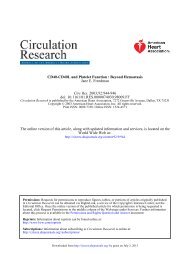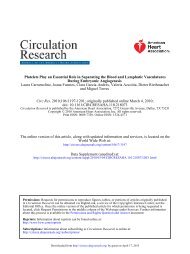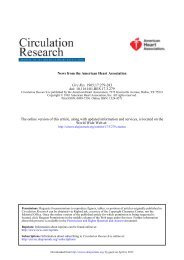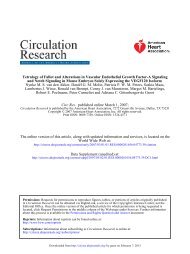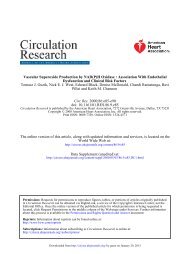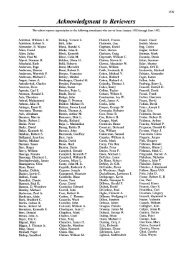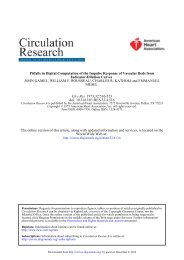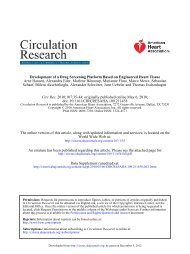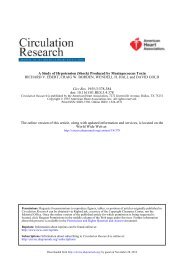Role of Sarcoplasmic Reticulum in Arterial Contraction: Comparison ...
Role of Sarcoplasmic Reticulum in Arterial Contraction: Comparison ...
Role of Sarcoplasmic Reticulum in Arterial Contraction: Comparison ...
Create successful ePaper yourself
Turn your PDF publications into a flip-book with our unique Google optimized e-Paper software.
100 mg<br />
Ashida et al Ryanod<strong>in</strong>e, <strong>Sarcoplasmic</strong> <strong>Reticulum</strong>, and <strong>Arterial</strong> <strong>Contraction</strong> 859<br />
Ryanod<strong>in</strong>e 10 |iM<br />
NE K<br />
100 mM<br />
Verapamil 10<br />
H,m). The cytoplasm <strong>of</strong> these cells (Figures 11 and 12)<br />
was characterized by numerous fibrils and dense bodies<br />
that were not prom<strong>in</strong>ent <strong>in</strong> the rat aortic cells. The SR<br />
was very sparse and was concentrated <strong>in</strong> the region just<br />
under the plasma membrane; some SR, as well as rough<br />
endoplasmic reticulum, was also located <strong>in</strong> the region<br />
around the nucleus. The few mitochondria observed<br />
were generally conf<strong>in</strong>ed to the region around the<br />
nucleus and to the periphery, just under the plasma<br />
membrane.<br />
Morphometric analysis (Table 2) <strong>in</strong>dicated that rat<br />
aortic myocytes conta<strong>in</strong> substantially more SR and<br />
rough endoplasmic reticulum than do bov<strong>in</strong>e tail artery<br />
myocytes. The SR accounts for about 5.4% <strong>of</strong> the<br />
nucleus-free cytoplasmic volume <strong>in</strong> the rat aortic cells<br />
but for only about 2.3% <strong>in</strong> the bov<strong>in</strong>e tail artery cells.<br />
Furthermore, the latter value may be an overestimate.<br />
Because much <strong>of</strong> the SR <strong>in</strong> these cells was located<br />
adjacent to the plasma membrane, it was <strong>of</strong>ten difficult<br />
to dist<strong>in</strong>guish surface <strong>in</strong>vag<strong>in</strong>ations ("caveolae") from<br />
SR. Thus, some surface <strong>in</strong>vag<strong>in</strong>ations, which did not<br />
exhibit clear open<strong>in</strong>gs to the extracellular space, were<br />
<strong>in</strong>cluded <strong>in</strong> the SR counts.<br />
Discussion<br />
Mechanism <strong>of</strong> Action <strong>of</strong> Ryanod<strong>in</strong>e<br />
Our results demonstrate that <strong>in</strong> arterial smooth<br />
muscle, ryanod<strong>in</strong>e selectively blocks evoked SR calcium<br />
release but has little effect on gated calcium entry.<br />
The mechanism <strong>of</strong> action <strong>of</strong> ryanod<strong>in</strong>e, however, is still<br />
unresolved. There is evidence that one effect is to<br />
ma<strong>in</strong>ta<strong>in</strong> SR calcium release channels <strong>in</strong> an open<br />
state, 17 "" produc<strong>in</strong>g a functional blockade <strong>of</strong> release as<br />
a result <strong>of</strong> depletion <strong>of</strong> the SR calcium store. Nevertheless,<br />
the effect <strong>of</strong> ryanod<strong>in</strong>e seems to depend on the<br />
20 m<strong>in</strong><br />
|1 Verapamil 10<br />
k —<br />
NE K<br />
100 mM<br />
K<br />
50 mM<br />
FIGURE 7. <strong>Comparison</strong> <strong>of</strong> effects <strong>of</strong> ryanod<strong>in</strong>e and<br />
verapamil on the norep<strong>in</strong>ephr<strong>in</strong>e (NE)- and 100 mM<br />
K-evoked contractions <strong>in</strong> rat aortic r<strong>in</strong>g. After the<br />
<strong>in</strong>troduction <strong>of</strong> 10 \iM ryanod<strong>in</strong>e, the contraction<br />
response to 6 x 10'' M NE was much more markedly<br />
attenuated (by 55%) than was the response to 100 mM<br />
K (by 10%). Responses to NE (<strong>in</strong> the presence <strong>of</strong><br />
ryanod<strong>in</strong>e) and 100 mM K were both greatly reduced<br />
by 10 \iM verapamil. Rest<strong>in</strong>g tension, 500 mg.<br />
experimental conditions' 8 - 32 " 34 ; ryanod<strong>in</strong>e blocks caffe<strong>in</strong>e<br />
contractions under some circumstances, 33 but not<br />
under others. 34 A possible explanation for these divergent<br />
observations is that ryanod<strong>in</strong>e locks the SR<br />
calcium release channels <strong>in</strong> a subconduct<strong>in</strong>g or "leaky"<br />
state 27 - 35 but does not prevent SR calcium uptake. Thus,<br />
with a large calcium <strong>in</strong>flux, or with a low concentration<br />
or brief exposure to ryanod<strong>in</strong>e, the SR calcium store<br />
may not be totally depleted.<br />
In tracer flux studies, 20 ryanod<strong>in</strong>e promoted calcium<br />
efflux from rabbit aorta, presumably because it<br />
enhanced passive SR calcium release. The subsequent<br />
suppression <strong>of</strong> NE- and caffe<strong>in</strong>e-<strong>in</strong>duced contractions<br />
could then be expla<strong>in</strong>ed by the depletion <strong>of</strong> the SR<br />
calcium store. Our observations are consistent with<br />
the view that ryanod<strong>in</strong>e causes slow release <strong>of</strong> calcium<br />
from the SR <strong>in</strong>to the myoplasmic space. The data also<br />
suggest that ryanod<strong>in</strong>e, like caffe<strong>in</strong>e, 2 - 8 may be very<br />
useful for separat<strong>in</strong>g sarcolemmal calcium transport<br />
mechanisms from SR calcium sequestration mechanisms<br />
because ryanod<strong>in</strong>e does not appear to affect<br />
calcium movement across the sarcolemma. 18<br />
<strong>Comparison</strong> <strong>of</strong> <strong>Contraction</strong>s <strong>in</strong> Rat Aorta and Bov<strong>in</strong>e<br />
Tail Artery: Structure-Function Relations<br />
Rat aorta exhibits a substantial caffe<strong>in</strong>e contraction<br />
that is ryanod<strong>in</strong>e-sensitive. The implication is that rat<br />
aortic smooth muscle has a relatively large SR store<br />
<strong>of</strong> calcium. This view is supported by the morphologic<br />
observations that <strong>in</strong>dicate that the SR accounts for a<br />
much larger fraction <strong>of</strong> the nonnuclear cytoplasmic<br />
volume <strong>in</strong> this tissue than <strong>in</strong> bov<strong>in</strong>e tail artery.<br />
Moreover, evoked SR calcium release may play an<br />
important role <strong>in</strong> excitation-contraction coupl<strong>in</strong>g <strong>in</strong><br />
rat aorta because nearly half <strong>of</strong> the NE-<strong>in</strong>duced<br />
Downloaded from<br />
http://circres.ahajournals.org/ by guest on April 6, 2013<br />
FIGURE 8. Effect <strong>of</strong> 10 \iM verapamil on contractile<br />
responses <strong>of</strong> r<strong>in</strong>g <strong>of</strong> bov<strong>in</strong>e tail artery to 50 mM K and<br />
to 2 x 10'" M norep<strong>in</strong>ephr<strong>in</strong>e (NE). Periods dur<strong>in</strong>g<br />
which 50 mM K and verapamil were present are<br />
<strong>in</strong>dicated by appropriately labeled bars. NE was<br />
<strong>in</strong>troduced (by bolus <strong>in</strong>jection) at times <strong>in</strong>dicated by<br />
arrowheads. Rest<strong>in</strong>g tension, 500 mg.




